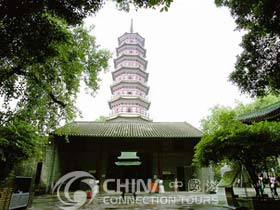
 The Temple of the Six Banyan Trees is a famous Buddhist temple in Guangzhou, and the site of the Guangzhou Buddhist Association nowadays. It is a pretty and exceptionally well maintained temple situated in the heart of Guangzhou. Built in 537, it is a renowned Buddhist cultural site. The temple enshrines three large Buddhist statues--the biggest copper Buddhist statues existing in Guangdong province. The thousand-Buddha copper pillar cast in the Yuan Dynasty (1271-1368) is kept on the top story of the pagoda. The 184-foot pagoda appears to have nine stories; inside, however, there are 17 levels. Because of the colorful exterior carvings, it is popularly known as the Flower Pagoda.
The Temple of the Six Banyan Trees is a famous Buddhist temple in Guangzhou, and the site of the Guangzhou Buddhist Association nowadays. It is a pretty and exceptionally well maintained temple situated in the heart of Guangzhou. Built in 537, it is a renowned Buddhist cultural site. The temple enshrines three large Buddhist statues--the biggest copper Buddhist statues existing in Guangdong province. The thousand-Buddha copper pillar cast in the Yuan Dynasty (1271-1368) is kept on the top story of the pagoda. The 184-foot pagoda appears to have nine stories; inside, however, there are 17 levels. Because of the colorful exterior carvings, it is popularly known as the Flower Pagoda.
The original name of the temple was "Baozhuang Yanshi". After it was affected by fire and renovated, its name became "Jingwei Shi". However, in 1100, the literary writer Su Dongpo of the Song Dynasty came here to visit, and when he saw the 6 banyan trees in the temple, he gave the name "the Temple of the Six Banyan Trees" to this structure. The "Six Banyan" board on the lintel that still exists today was handwritten by Su. The temple has a total area of 7,000 square meters and consists of the Liuzu Hall, the Guanyin Hall, the Baorong Pavilion and the tablet Corridor, etc. In the Liuzu Hall, there is the bronze statue of the founder of Zen Buddhism, Wei Neng, for worshipping. It weighs more than 1,000 catties and its beauty reflects the superb casting skill of the foundry worker. In the Guanyin Hall, there is a highly valuable Guanyin statue 4 meters tall. As for the Baorong Pavilion and the Tablet Corridor, there is abundant greenery on both sides, and one of the tablets recording the history of the Temple was preserved.

